 New
rules limit the hours that medical residents can spend in hospitals—and they highlight
an underlying shift in physician philosophy and culture.
New
rules limit the hours that medical residents can spend in hospitals—and they highlight
an underlying shift in physician philosophy and culture.
If
you can get to the showers in the morning, then it’s been a good call day,”
says Jim Sur, a month into his first year—the intern year—as an internal-medicine
resident at the University of Chicago Hospitals. “Or a change of socks. It helps
you feel refreshed.”
“Really? You shower?”
asks second-year resident Kevin Schaefer, Sur’s mentor during their monthlong
gastroenterology (GI) rotation. “Change of socks, huh? That’s good.”
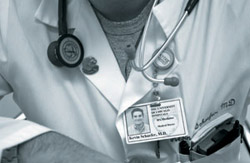 It’s
a Wednesday, and the two are on call. It’s their turn, as on every fourth day,
to spend the night at the Hospitals. They arrive at 7 a.m., take charge of the
previous day’s four patients, and admit four or five more in the course of the
day. Around 2 p.m., they check on an 80-year-old woman complaining of stomach
pains. Sur, tall and sandy-blond, and Schaefer, shorter with dark-rimmed glasses,
stand on either side of her bed, each wearing well-cushioned, leather clogs below
their white coats. Sur questions the woman in a friendly, audible voice: “Were
there streaks of blood on the stool?” “Was there blood on the toilet paper?” “Have
you been bringing up vomit?”
It’s
a Wednesday, and the two are on call. It’s their turn, as on every fourth day,
to spend the night at the Hospitals. They arrive at 7 a.m., take charge of the
previous day’s four patients, and admit four or five more in the course of the
day. Around 2 p.m., they check on an 80-year-old woman complaining of stomach
pains. Sur, tall and sandy-blond, and Schaefer, shorter with dark-rimmed glasses,
stand on either side of her bed, each wearing well-cushioned, leather clogs below
their white coats. Sur questions the woman in a friendly, audible voice: “Were
there streaks of blood on the stool?” “Was there blood on the toilet paper?” “Have
you been bringing up vomit?”
Meanwhile,
Schaefer—his pockets stuffed with papers, medical charts, stethoscope—heads down
the hall to the resident work room, a narrow space that holds five computers.
In front of each a resident completes patient forms while Schaefer confers with
a post-call resident about a GI transfer patient.
Throughout
the day Schaefer and Sur return to the work room or find empty tables to frantically
scribble notes on forms. At midnight the “night-float” team—residents who cover
all nighttime internal-medicine patients and admissions—takes on patient-admission
responsibility. Schaefer goes to bed in the dorm-like call room, where phones
are mounted on the wall next to each bunk. Sur covers the patients of the three
GI teams not on call—about 20 cases in all. When he finishes his paperwork around
2:15 a.m., he too enters the call room. At 3 a.m. he turns his pager over to the
night-float team and sleeps. Schaefer’s pager wakes them at 5:45 a.m., when a
patient must be transferred to the Intensive Care Unit.
At
7 a.m., now post-call, they “round” with the attending physician, sharing patient
histories, complaints, tests ordered, prognoses delivered. The attending suggests
next steps, which Sur and Schaefer perform that day. After transferring their
remaining patients to the next on-call team, they leave the Hospitals around 5
p.m. Thursday—after a 34-hour shift.
 In
his first month as an intern, Sur’s on-call sleep time has ranged from zero to
four hours. “At the end of a post-call day,” he says, “you feel like your higher-level
thinking is a little slower, but you can just talk to your senior resident,” who’s
had slightly more sleep, “and he’ll pick up the work for you.”
In
his first month as an intern, Sur’s on-call sleep time has ranged from zero to
four hours. “At the end of a post-call day,” he says, “you feel like your higher-level
thinking is a little slower, but you can just talk to your senior resident,” who’s
had slightly more sleep, “and he’ll pick up the work for you.”
This
immersion-style training, with some residents working more than 100 hours
a week, takes place at teaching hospitals all over the United States. It’s part
of a tradition that dates back to 1897, when Johns Hopkins University surgeon
William Halsted introduced the German-based concept at Hopkins’s fledgling medical
school. Participants in the post-internship, advanced specialty training lived,
in fact, in hospital quarters; they also worked 24-hour days year-round for little
or no pay and were discouraged from marrying. Despite the lifestyle’s rigors,
by the end of World War II the Hopkins model was more the rule than the exception,
as physicians sought the prestige and financial rewards that came with resident
training and certification. Over the past half century the system transformed:
the pay improved, marriage became acceptable, and residents moved out of the hospital.
The 24/7 work schedule also disappeared,
but hours have remained long. The schedules, critics argue, create overworked,
overtired physicians who suffer physical, emotional, and mental problems—and pose
potential hazards for patients.
And it appears
the critics finally have won their case. In June the Accreditation Council of
Graduate Medical Education (ACGME), the national group that in the 2002–2003 academic
year accredited 7,813 residency programs, including Chicago’s, announced new resident-hour
requirements. Residents will be able to work no more than 80 hours a week averaged
over four weeks, though programs can apply for a 10 percent or eight-hour-a-week
increase. They must have at least one 24-hour period off per week and no more
than every third night on call (again averaged over four weeks). Allowed to work
no more than 24 continuous duty hours—plus six hours for transferring patients
and attending educational conferences—residents also must have ten hours off between
duty periods. Programs violating the rules risk losing accreditation—and thus
federal funds.
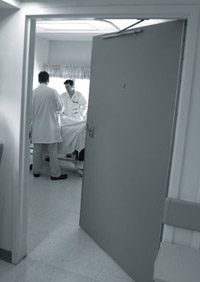 The
new rules, which take effect July 1, 2003, mark a drastic change for many teaching
hospitals, institutions that have come to rely on residents—who fall into a hazy
no-man’s-land between students and employees—not only for physician services but
also for secondary work such as transporting patients around the hospital, scheduling
appointments, and completing paperwork. For the number of hours many residents
currently work, their $30,000 to $40,000 annual salary is a bargain compared to
what hospitals would pay transport, physicians’, and nurses’ aides.
The
new rules, which take effect July 1, 2003, mark a drastic change for many teaching
hospitals, institutions that have come to rely on residents—who fall into a hazy
no-man’s-land between students and employees—not only for physician services but
also for secondary work such as transporting patients around the hospital, scheduling
appointments, and completing paperwork. For the number of hours many residents
currently work, their $30,000 to $40,000 annual salary is a bargain compared to
what hospitals would pay transport, physicians’, and nurses’ aides.
Hospitals
have been slow to hire more help, particularly after the 1997 Balanced Budget
Act slashed federal funds for resident support. Though the government has eased
the cuts each year since 1997—instead of a $3 million drop in resident support,
Chicago now might face a $1 million or $1.5 million cut, says Michael Koetting,
the Hospitals’ vice president for planning—the focus is on efficiency.
“There’s
a much higher focus on measuring how we operate,” says Michael Riordan, president
and CEO of the University of Chicago Hospitals. Already, he says, the Hospitals—which
U.S. News & World Report ranked the 14th best overall U.S. hospital in July—have
improved the time it takes to transfer a patient, answer a call, clean up a room.
But he admits that Chicago must alleviate grunt work for its 483 residents. “We
have to look at our internal operations and streamline them,” Riordan says. “We
need to do a better job with transportation, providing the right level and mix
of support, a smaller reliance on agency nurses”—who don’t know the Hospitals
as well.
The new hour limits go well beyond
administrative and budget issues. They also underscore a massive ideological change,
as a new vision challenges the traditional ideal of a physician—a shift evident
at Chicago.
Defenders
of the tradition often define residents’ long hours as character building.
In fact, as Andrew Abbott, AM’75, PhD’82, the Gustavus F. and Ann M. Swift distinguished
service professor and chair of sociology, who wrote The System of Professions
(1988), points out, the modern medical system emerged in the late 19th century,
when a profession’s legitimacy hinged on its character. “The medical character
was that the doctor should cultivate equanimity,” Abbott says. “These are the
guys learning to take excessive demand and then more demand on top of that. There
is a macho quality to it.”
Abbott’s analysis
is echoed by Fred Brown, an associate professor and recent interim chief of neurosurgery.
The traditional, time-sucking residency, he says, “selects out people who have
stamina, who can perform under pressure. The strong survive. After a residency,
that’s one tough surgeon.” Brown takes issue with studies showing sleep deprivation
weakens performance. “You put your fatigue aside,” he says. “You’re almost bemused
if someone says, ‘You’ve just done three surgeries; are you sure you feel rested
enough for this next one?’ It’s a matter of pride. It’s like you come out of boot
camp in good fighting shape. It’s like running a marathon. Your body’s telling
you that you can’t do it, but you do. You realize that what you’re doing is so
important that your fatigue is relatively trivial.”
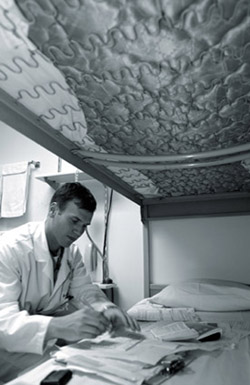 Like
all professions, Abbott says, medicine faces the question of whether it is “about
character or about technique.” Today, he believes, “there is a move against this
in-your-face, over-the-top character education. It could be a general move in
all forms of education away from confrontation and challenge.”
Like
all professions, Abbott says, medicine faces the question of whether it is “about
character or about technique.” Today, he believes, “there is a move against this
in-your-face, over-the-top character education. It could be a general move in
all forms of education away from confrontation and challenge.”
It’s
a move some fear could weaken medical training. They point out that the long hours
let a resident follow patients from admission through treatment and to monitor
their response to care. And more time in the clinics, on the floors, and in the
operating rooms means more experience.
“There’s
general agreement among surgeons that residents spend too much time in the hospital,”
notes Lew Schwartz, MD’87, associate surgery professor and associate residency-program
director. “But it’s inevitable that with fewer hours, surgical trainees will do
fewer operations.”
He points out that the
new limits will not keep residents from being tired. After all, they’ll still
work 80-plus hours a week.
This presents
a catch-22. “If you’re tired you’re not going to be as effective,” Schwartz admits.
“But you’re not learning surgery by being at home.” Under the new hour rules,
which Chicago’s general-surgery section has implemented already, “residents must
be excluded from some major operations, even those performed during the day.”
“The
basic paradigm of surgery has produced some pretty good surgeons,” agrees Bruce
Gewertz, the Dallas B. Phemister professor and surgery department chair. “The
fear is, if we sacrifice that immersion experience, are we going to produce surgeons
that aren’t tough enough?”
Perhaps so, says
Gewertz, who chairs an Association of American Medical Colleges national task
force on integrating patient care and medical education. “But it’s also possible
you’ll have surgeons who are more well rested and attentive to patients.” If teaching
hospitals were kinder to residents, he says, residents might extend that kindness
to patients. “Maybe more than the 80-plus-eight hours is that we need to take
a totally different approach toward residents.”
“It’s
a matter of changing the whole culture and philosophy of medical education,” argues
Lucian Leape, an adjunct professor of health policy at Harvard University. “Residency
is meant to imbue in young doctors a deep sense of responsibility for the patient,”
he concedes, but “I don’t agree that the only way to do that is to work night
and day.”
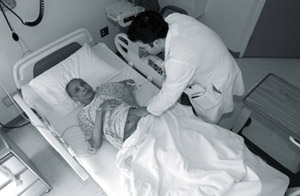 Leape
believes the hour rules are actually the touchstone of a much larger issue: “the
dehumanization of residents.” Training programs, he says, “really do a number
on residents—the workload, the hours, the way they’re treated. They get angry,
depressed, frustrated.”
Leape
believes the hour rules are actually the touchstone of a much larger issue: “the
dehumanization of residents.” Training programs, he says, “really do a number
on residents—the workload, the hours, the way they’re treated. They get angry,
depressed, frustrated.”
Discussions of kindness
over hard work are fairly new to medicine—and increasingly common across the professions.
Sociologist Abbott suspects that the proliferation of women in many fields has
aided the humanization of education. The percentage of female doctors rose from
15.8 percent in 1983 to 24.5 percent in 2000, and about 43 percent of graduating
medical students in 2001 were women.
Jordan
Cohen, president and CEO of the Association of American Medical Colleges (AAMC),
agrees the influx of women has added to a changed outlook. “Many residents are
married now, and many are women, which has produced a healthy change in attitude
in the profession—that there are other responsibilities in life that should take
priority,” he says. “When I was a resident 40 years ago, we worked every other
night and every other weekend. My cohort of residents anticipated that our life
would be entirely devoted to our profession. My wife—and I was one of few who
were married—understood that she was marrying someone who had a mistress, namely
medicine. We accepted the hours and lifestyle without complaint because this was
the nature of the profession.”
Residents
today view their careers as only a part of their lives, says Cohen, vice chair
of medicine at Chicago’s Michael Reese Hospital from 1982 until 1988. In 1987
Cohen, then chair of the ACGME’s internal-medicine Residency Review Committee,
implemented national resident-hour reforms—a precursor to the recent, industry-wide
rules. “Residents deserve to have enough time to pursue other interests so they
can remain well rounded,” he says. Indeed, second-year internal-medicine resident
Melinda Henderson is grateful for the new rules. “I think the change will be huge
in being able to maintain a life outside the hospital,” she says. “Right now you’re
so exhausted, and there’s no time to do anything.”
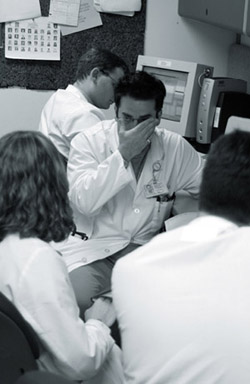 In
March 1984 18-year-old Libby Zion was admitted to Cornell Medical Center’s
New York Hospital emergency room with a high fever, chills, and dehydration. A
few hours later, under the care of residents, she died. Her father, a New York
Times columnist and former federal prosecutor, called for a grand jury investigation.
In its 1986 report, the grand jury found neither hospital nor physicians at fault.
It did cite the residency and physician-training systems as potential dangers:
New York Hospital residents routinely worked more than 100 hours a week; second-
and third-year residents supervised entire wards and services, with attending
physicians available only by phone; and residents provided patient care for 30
or 40 hours at a stretch.
In
March 1984 18-year-old Libby Zion was admitted to Cornell Medical Center’s
New York Hospital emergency room with a high fever, chills, and dehydration. A
few hours later, under the care of residents, she died. Her father, a New York
Times columnist and former federal prosecutor, called for a grand jury investigation.
In its 1986 report, the grand jury found neither hospital nor physicians at fault.
It did cite the residency and physician-training systems as potential dangers:
New York Hospital residents routinely worked more than 100 hours a week; second-
and third-year residents supervised entire wards and services, with attending
physicians available only by phone; and residents provided patient care for 30
or 40 hours at a stretch.
In 1987—the same
year the ACGME adopted hour reforms in six disciplines, including internal medicine—New
York’s health commissioner appointed a committee to study the grand jury’s findings.
Calling for 24-hour supervision of residents in acute-inpatient units, the committee
also recommended limits on resident duty hours—including 80-hour work weeks, 24-hour
shifts, and at least one day off per week. When the recommendations became state
law in 1989, the state provided $200 million for hospitals to hire additional
aides and board-certified physicians to maintain service.
Adding
to the reform movement’s ammunition was a barrage of sleep deprivation research.
In a 1991 Journal of the American Medical Association survey of 145 residents,
41 percent cited fatigue as a cause of their most serious mistake. A July–August
1997 Nature report found that staying awake for 24 hours impairs thought processes
as much as does a blood-alcohol level of 0.1 percent—higher than many states’
legal driving limits. A study in the March 2002 Annals of Internal Medicine showed
that three-fourths of residents at the University of Washington suffered from
burnout—emotional exhaustion or detachment from patients. Other studies linked
resident schedules to increased car accidents, mental health problems, and pregnancy
complications.
The clincher came in 1999
when the Institute of Medicine, associated with the National Academy of Sciences,
reported that medical errors may play a role in 44,000 to 98,000 deaths a year.
In the public outcry that followed, the American Medical Student Association (AMSA)
approached Rep. John Conyers, D-Mich., about proposing legislation based on the
New York regulations. The bill now has more than 70 cosponsors in the House and
a companion bill in the Senate, introduced in July by Democratic New Jersey Sen.
Jon Corzine, MBA’73.
Public scrutiny mounted
last year when the medical students’ association, along with the Committee of
Interns and Residents (a union created in 1999) and Ralph Nader’s group Public
Citizen, submitted a petition to the Occupational Safety and Health Administration
calling for duty-hour limits.
 Because
many in the medical community are loath to submit to government guidelines, the
legislative threat was a major catalyst for the ACGME’s proposals, says the group’s
executive director, David Leach. The proposals were soldered by a committee that
weighed hospital, physician, resident, patient, public, and lawmaker interests—and
not everyone is pleased.
Because
many in the medical community are loath to submit to government guidelines, the
legislative threat was a major catalyst for the ACGME’s proposals, says the group’s
executive director, David Leach. The proposals were soldered by a committee that
weighed hospital, physician, resident, patient, public, and lawmaker interests—and
not everyone is pleased.
Some want the rules
to go even further. AMSA President Eric Hodgson—who graduated from University
of Maryland School of Medicine in May and is taking a year off before his residency—is
“very happy that they’re addressing” the issue, but the legislation, he argues,
“would have more teeth,” in part because “violator information would be shared
with the public.” He’s also concerned about enforcement. “In New York,” he says,
“the rules were in place for 11 years before they were enforced.”
In
fact, a 1998 New York Department of Health investigation of 12 hospitals statewide
found that while resident supervision had improved, all the institutions violated
the duty-hour limits. Thirty-seven percent of residents worked more than 85 hours
a week; 20 percent exceeded 95 hours a week (60 percent among surgical residents);
and 38 percent worked more than 24 consecutive hours. To improve compliance, in
2000 New York passed a law increasing noncompliant hospitals’ monetary penalty,
which now can reach $50,000 for repeat offenders. To measure adherence, the state
hired an investigative agency to make annual surprise visits to teaching hospitals.
Paying
a fine is one thing; losing accreditation is quite another, especially when up
to $100 million in federal funds is at stake. That’s why the ACGME’s rules will
work where New York’s lagged, Leach says. His group, he insists, has the resources
to enforce the rules. With the expenses built into its fees, the group plans to
survey every resident in the United States, shorten the length of its review cycles,
and possibly hire more site visitors. “Whatever it costs,” Leach says, “we can
do it.”
Although Leach says only a minority
of programs need drastic changes, some of the nation’s top institutions feel the
pressure. In May, for example, the ACGME threatened to strip Yale–New Haven Medical
Center’s general-surgery program of its accreditation unless it reduced resident
hours.
Another complaint is that resident
hours haven’t been cut enough. Given the sleep-deprivation studies, 24-hour workdays
are still too long, says Harvard’s Leape, a member of the Institute of Medicine.
Residents should work 14-hour periods, with the final two hours of a shift devoted
to patient handovers. That’s an 84-hour, six-day week, very near the ACGME plan.
But
ACGME’s Leach believes the 24-hour rule is adequate. “Rounding from 7 a.m. to
7 a.m. doesn’t mean I’ve been up for 24 hours,” he points out. Still, if Sur is
any example, less than four hours of sleep is the norm for on-call interns and
residents.
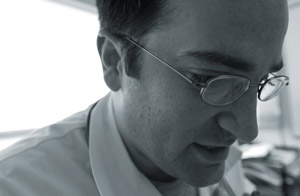 Others
believe the limits jeopardize the quality of resident education. Neurosurgery’s
Brown, a Hospitals resident from 1973 to 1978, predicts the new rules will reduce
exposure to the operating room by 40 percent. “What if someone has his 80 hours,
and some surgery comes in that you only see every 10 years? We’re going to tell
the resident, ‘Go home’?”
Others
believe the limits jeopardize the quality of resident education. Neurosurgery’s
Brown, a Hospitals resident from 1973 to 1978, predicts the new rules will reduce
exposure to the operating room by 40 percent. “What if someone has his 80 hours,
and some surgery comes in that you only see every 10 years? We’re going to tell
the resident, ‘Go home’?”
To offset the
decreased O.R. exposure, Chicago’s neurosurgery section has added a year to its
six-year residency program. Most other neurosurgery programs already were seven
years and many are increasing to eight years. Also, residents on a monthlong lab
rotation, who formerly didn’t see patients, now may work a 24-hour call shift
on Saturdays and receive extra compensation.
Brown
worries that if residents leave after 24 hours, they’ll get the wrong idea about
the lifestyle of a surgeon, who may work all day and night. That lifestyle, however,
has caused a recent drought of recruits. The number of medical students entering
surgery dropped 25 percent from 1992 to 2001, and last year 68 surgical residency
slots in 40 programs nationwide went unfilled. As a result, many departments,
including Chicago’s, are trying to improve residents’ quality of life.
“We’ve
been committed to reform long before it became an ACGME mandate,” says Fabrizio
Michelassi, the Thomas D. Jones professor and general-surgery section chief, who
directs the general-surgery residency program. In fact, the general-surgery section
(separate from neurosurgery) changed its program to follow the new ACGME rules
in July—a year early.
Under the new system,
says associate residency-program director Schwartz, residents work three days
of 12-hour shifts. On the fourth day they’re on call and stay through the night,
going home the next day after 24 hours. Before the change residents sometimes
worked up to 100 hours a week.
To make the
new hours work, Michelassi increased the number of residents staffing the busier
clinical services, such as general, vascular, and transplant, so the on-call residents
can leave after a 24-hour shift. And the section, Michelassi says, continues to
study how residents spend their shifts, recently asking them to keep time logs.
Second-year surgery resident Mark Villa has noticed the change. “You have a whole
bunch more free time,” he says. “And when you’re here you’re more awake and alert
and doing what needs to be done.”
With fewer
hours he’s more careful when transferring patients to the next team, outlining
all the necessary information. During his off-hours he calls the other second-year
on his team to check on patients.
 Chicago’s
internal-medicine department is more experienced with reform. A car service,
for example, drives overtired residents home, and attending physicians complete
patient procedures that residents aren’t up to performing. (“When it’s your 32nd
hour and you need to stick a needle in someone to drain fluid, it’s nice to have
someone who’s less tired,” says second-year Josh Liberman.)
Chicago’s
internal-medicine department is more experienced with reform. A car service,
for example, drives overtired residents home, and attending physicians complete
patient procedures that residents aren’t up to performing. (“When it’s your 32nd
hour and you need to stick a needle in someone to drain fluid, it’s nice to have
someone who’s less tired,” says second-year Josh Liberman.)
But
while the department has no hesitation about adhering to the new rules, the question
is how.
“It’s frustrating,” chief resident
Ethan Gundeck says, “because our program has been progressive in enforcing rules
to make residents’ lives more pleasant. Now we have to make fairly drastic changes
that might compromise patient care.”
The
24-hour shift requirement will be difficult to follow, in part because residents
are highly motivated and ready for action, says Holly Humphrey, MD’83, the Pritzker
School of Medicine’s associate dean of students and internal-medicine residency-program
director. “I’ve had some eager beavers at the beginning come in on their day off,”
she says, and they are often “shocked” when she tells them that is not allowed.
In some internal-medicine units, like intensive care, Humphrey admits, residents
routinely break the 80-hour rule because caring for the sickest patients amounts
to a heavy load.
She and her team of chief
residents are exploring ways to comply with the new requirements. In one scenario,
instead of having a few residents on call each night, about half would work a
day shift from 7 a.m. to 7 p.m., and the rest would staff the night shift. That
option isn’t ideal because at night few attendings are on duty and routine tests
are difficult to conduct. Humphrey also worries residents would adopt a shift-work
mentality and feel less accountable for their patients.
Another
possibility is to have on-call residents arrive at noon instead of 7 a.m. and
still go home around 5 p.m. the next day. That option, which Vineet Arora, internal
medicine’s other chief resident, says might be the best solution, adheres to the
24-hour rule but doesn’t help residents get more sleep. “If on-call residents
don’t get here until noon,” she says, “they probably won’t get to sleep by 3 a.m.,
or at all.”
Hiring physicians’ assistants
to ease residents’ workload, asking the faculty to work more hours, or hiring
hospitalists—physicians who care for patients without resident aid—are also possible
solutions. But Humphrey doesn’t know where the funding for these approaches would
come from.
She’s pleased the accreditation
council will let residents work six extra daily hours to transfer patients and
attend educational conferences, which she believes indicates that the ACGME is
“trying to accomplish the right things. If you can’t talk to the next shift, it
is detrimental to the patient’s care. You’d have doctors taking care of patients
they don’t know.”
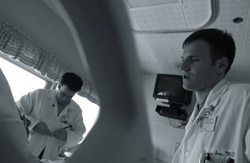 At
an internal-medicine house-staff lunch, residents wearing comfortable shoes
and various mixes of white jackets, blue scrubs, khakis, and T-shirts chat over
pasta, chicken, green beans, carrots, and the constant chirp of beepers. As Arora
and Humphrey recite a long list of announcements, second-year Liberman’s eyes
begin to glaze over behind his metal-rimmed glasses. On post-call cardiology duty,
he had felt awake until the speeches began. Last night he got an unusual amount
of on-call sleep—about 5 1/2 hours. His team’s interns, Ryan Kamp and Lisa Barker,
got to bed around 2:30 a.m. “It was a really quiet night,” Liberman says. “A couple
chest pains, some shortness of breath, three congestive heart failures.”
At
an internal-medicine house-staff lunch, residents wearing comfortable shoes
and various mixes of white jackets, blue scrubs, khakis, and T-shirts chat over
pasta, chicken, green beans, carrots, and the constant chirp of beepers. As Arora
and Humphrey recite a long list of announcements, second-year Liberman’s eyes
begin to glaze over behind his metal-rimmed glasses. On post-call cardiology duty,
he had felt awake until the speeches began. Last night he got an unusual amount
of on-call sleep—about 5 1/2 hours. His team’s interns, Ryan Kamp and Lisa Barker,
got to bed around 2:30 a.m. “It was a really quiet night,” Liberman says. “A couple
chest pains, some shortness of breath, three congestive heart failures.”
The
threesome goes home around 3 p.m.—a 32-hour shift that, they agree, is as good
as it gets. In another year, days like this will be obsolete; residents will work
24- to 30-hour periods. Liberman hopes the new rules strike the right balance
between total-immersion training and life outside the Hospitals. Optimistically,
he notes, “There’s a happy medium somewhere.”


![]() Contact
Contact
![]() About
the Magazine
About
the Magazine ![]() Alumni
Gateway
Alumni
Gateway ![]() Alumni
Directory
Alumni
Directory ![]() UChicago
UChicago![]() ©2002 The University
of Chicago® Magazine
©2002 The University
of Chicago® Magazine ![]() 5801 South Ellis Ave., Chicago, IL 60637
5801 South Ellis Ave., Chicago, IL 60637![]() fax: 773/702-0495
fax: 773/702-0495 ![]() uchicago-magazine@uchicago.edu
uchicago-magazine@uchicago.edu
 It’s
a Wednesday, and the two are on call. It’s their turn, as on every fourth day,
to spend the night at the Hospitals. They arrive at 7 a.m., take charge of the
previous day’s four patients, and admit four or five more in the course of the
day. Around 2 p.m., they check on an 80-year-old woman complaining of stomach
pains. Sur, tall and sandy-blond, and Schaefer, shorter with dark-rimmed glasses,
stand on either side of her bed, each wearing well-cushioned, leather clogs below
their white coats. Sur questions the woman in a friendly, audible voice: “Were
there streaks of blood on the stool?” “Was there blood on the toilet paper?” “Have
you been bringing up vomit?”
It’s
a Wednesday, and the two are on call. It’s their turn, as on every fourth day,
to spend the night at the Hospitals. They arrive at 7 a.m., take charge of the
previous day’s four patients, and admit four or five more in the course of the
day. Around 2 p.m., they check on an 80-year-old woman complaining of stomach
pains. Sur, tall and sandy-blond, and Schaefer, shorter with dark-rimmed glasses,
stand on either side of her bed, each wearing well-cushioned, leather clogs below
their white coats. Sur questions the woman in a friendly, audible voice: “Were
there streaks of blood on the stool?” “Was there blood on the toilet paper?” “Have
you been bringing up vomit?”  In
his first month as an intern, Sur’s on-call sleep time has ranged from zero to
four hours. “At the end of a post-call day,” he says, “you feel like your higher-level
thinking is a little slower, but you can just talk to your senior resident,” who’s
had slightly more sleep, “and he’ll pick up the work for you.”
In
his first month as an intern, Sur’s on-call sleep time has ranged from zero to
four hours. “At the end of a post-call day,” he says, “you feel like your higher-level
thinking is a little slower, but you can just talk to your senior resident,” who’s
had slightly more sleep, “and he’ll pick up the work for you.” The
new rules, which take effect July 1, 2003, mark a drastic change for many teaching
hospitals, institutions that have come to rely on residents—who fall into a hazy
no-man’s-land between students and employees—not only for physician services but
also for secondary work such as transporting patients around the hospital, scheduling
appointments, and completing paperwork. For the number of hours many residents
currently work, their $30,000 to $40,000 annual salary is a bargain compared to
what hospitals would pay transport, physicians’, and nurses’ aides.
The
new rules, which take effect July 1, 2003, mark a drastic change for many teaching
hospitals, institutions that have come to rely on residents—who fall into a hazy
no-man’s-land between students and employees—not only for physician services but
also for secondary work such as transporting patients around the hospital, scheduling
appointments, and completing paperwork. For the number of hours many residents
currently work, their $30,000 to $40,000 annual salary is a bargain compared to
what hospitals would pay transport, physicians’, and nurses’ aides.  Like
all professions, Abbott says, medicine faces the question of whether it is “about
character or about technique.” Today, he believes, “there is a move against this
in-your-face, over-the-top character education. It could be a general move in
all forms of education away from confrontation and challenge.”
Like
all professions, Abbott says, medicine faces the question of whether it is “about
character or about technique.” Today, he believes, “there is a move against this
in-your-face, over-the-top character education. It could be a general move in
all forms of education away from confrontation and challenge.” Leape
believes the hour rules are actually the touchstone of a much larger issue: “the
dehumanization of residents.” Training programs, he says, “really do a number
on residents—the workload, the hours, the way they’re treated. They get angry,
depressed, frustrated.”
Leape
believes the hour rules are actually the touchstone of a much larger issue: “the
dehumanization of residents.” Training programs, he says, “really do a number
on residents—the workload, the hours, the way they’re treated. They get angry,
depressed, frustrated.” In
March 1984 18-year-old Libby Zion
In
March 1984 18-year-old Libby Zion  Because
many in the medical community are loath to submit to government guidelines, the
legislative threat was a major catalyst for the ACGME’s proposals, says the group’s
executive director, David Leach. The proposals were soldered by a committee that
weighed hospital, physician, resident, patient, public, and lawmaker interests—and
not everyone is pleased.
Because
many in the medical community are loath to submit to government guidelines, the
legislative threat was a major catalyst for the ACGME’s proposals, says the group’s
executive director, David Leach. The proposals were soldered by a committee that
weighed hospital, physician, resident, patient, public, and lawmaker interests—and
not everyone is pleased. Others
believe the limits
Others
believe the limits  Chicago’s
internal-medicine department
Chicago’s
internal-medicine department At
an internal-medicine house-staff lunch
At
an internal-medicine house-staff lunch